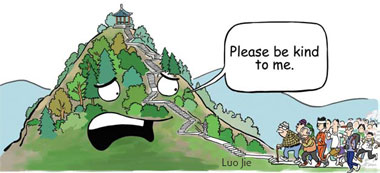How to enjoy and preserve the mountains
By Kazuo Yoneto (China Daily)
Updated: 2008-03-19 07:31
Updated: 2008-03-19 07:31
Last fall, after many years, I went hiking on Mount Tanigawadake, a 1,977-m mountain that spans Niigata and Gunma prefectures. I was amazed to see long lines of hikers snaking up the well-defined routes.
When I got to the summit, it, too, was packed with climbers, many of whom were middle-aged or older.
The ground around the peak was completely barren of grass or bushes. The entire surface was in a sad state. Here and there were bald patches of rock with no soil left at all.
Thanks to Japan's high economic growth, life was easier and welfare improved. People retired from their jobs and their children grew up and moved away from home.
Many retirees were left with too much time on their hands. Some took up tennis or other sports to stay in shape. But even people new to tennis have to practice with a partner before they can enjoy a game. In contrast, all that it takes to climb a mountain is gumption, energy and physical strength. Anyone can do it, if they have the mind to.
It is refreshing to come in contact with nature. Today, of Japan's 10 million climbers aged 20 or older, a little more than half are in their 50s or older. Generally speaking, because older people have more free time than the younger working population, they travel to mountainous areas more often, adding to the surge in the number of climbers.

Inevitably, human activities adversely affect natural environments. On mountains, climbers destroy the environment by trampling on delicate ground plants.
After millions of feet have beaten down the soil on a path, it begins to crumble and form ditches. When it rains, water rushes down them, leaching dirt and sand away.
To prevent this, logs are placed across paths to reinforce the soil and to act as stairs.
But stairs are hard on aging knees. Because of this, many climbers, especially when the ground is muddy and slippery after a rain, choose to walk in the surrounding grassland or woods, leading to more destruction of fragile plants.
Moreover, since trails are narrow, when climbers meet other people on the path, one usually steps off the path to let others pass. When hikers reach a good lookout spot, they step off the trail to enjoy the view or sit down to rest.
This spells death to the plants and mosses along the trails. They are trampled so often that they soon die, particularly in higher altitudes.
When ground plants wither, rain and snow runoff causing topsoil to flow from the barren hills.
And so the damage spreads.
The peaks of Mount Tanigawadake and Mount Togatake, which is in the Tanzawa mountain range in Kanagawa Prefecture, for example, are now so barren that the bedrock can be seen from the base of the mountains.
Last year, I visited Hakuba Oike pond in Nagano Prefecture for the first time in three decades. I recalled the breathtaking vistas of fields of flowers spreading before me and hoped to see them again. What I saw instead was a vast wasteland.
When I return to favorite mountains years later, I am often shocked to find the views I previously admired have drastically changed.
The most common way to prevent damage is to put up ropes along both sides of mountain trails so that climbers do not stray. Some mountains close down trails in extensively damaged areas or cordon off such areas with nets.
But once destroyed, nature cannot easily recover. Moreover, such environmental protection measures can be taken in only a small portion of Japan's vast mountainous areas.
Meanwhile, there has been a sharp rise in the number of climbers. The destruction continues.
To stop this trend, it is imperative that each and every hiker develop an awareness of nature's fragility and try to protect the environment.
In the past, many people belonged to alpine clubs, where older members taught younger ones the etiquette of mountain climbing along with mountaineering techniques.
Such hikers used to take pride in observing the rules. But now that the sport has become so popular, it is difficult for mountaineering organizations to educate everyone.
As an alternative, the nation needs a publicity campaign to ensure everyone works together to conserve our natural resources.
Such a campaign should focus on the primary cause of environmental destruction: people. It should urge climbers not to trespass beyond the boundaries of hiking courses.
For example, the Environment Ministry and mountaineering organizations should work together to inform publishers of mountaineering magazines so that they will run stories about environmental destruction and how to combat it.
Such information should also be included in hiking guidebooks. Maps should show areas where damage is serious and list rules that must be observed. Local governments and tourist associations should post such information on signboards at the start of trails and in pamphlets. Guide associations and travel agents should also urge hikers to stay on the paths.
We need to create an atmosphere of urgency to persuade climbers who wander off routes that they bring disgrace on the entire mountaineering community.
After all, the public's support of nature conservancy is one yardstick by which to measure the nation's level of cultural awareness.
The Asahi Shimbun
(China Daily 03/19/2008 page10)
|
|
|
|